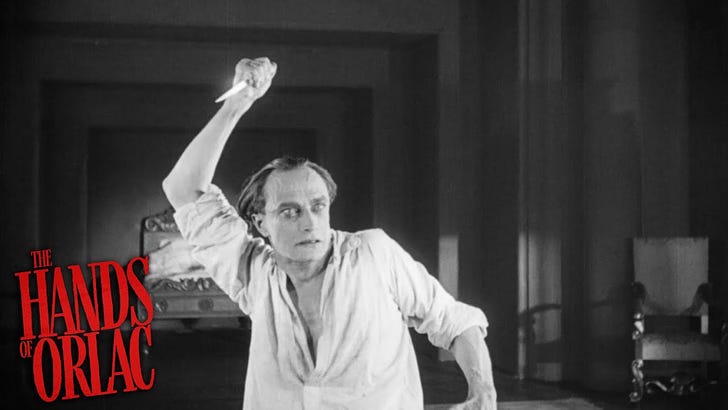Time for some silent horror fun!
Our countdown to Halloween continues this month at R-Rated Movie Club. Which of today’s selections have you read and/or seen? What should I write about next? Drop a comment and let me know!
Today we’re looking at three “scary” moments in the Bible. Well, okay, they’re not super scary. They’re not explicitly gory or haunting, not that sort of thing. Yet each in their own way has stuck with me in that way that makes me a little unnerved. We’ll see if you agree.
Those scripture passages are paired with three “scary” R-rated movies. Well, okay, all three of these silent moving pictures are from years before any sort of rating system and decades before the R rating. Nevertheless, they were all deemed quite scary in their day, and dare I say they can still be scary today, if you have an open mind and you’re in the mood for frights.
And with that, let’s jump back to 1924…
Blood on Your Hands? You’re in Trouble!
A silent horror classic if there ever was one, The Hands of Orlac is a 1924 Austrian film that still holds up today. Paul Orlac is a concert pianist whose hands are ruined in a train derailment (they clearly put a ton of money into setting up that train derailment scene and wanted to put every penny on the screen, given how much screen time it gets!). But good news: the doctors gave him new hands! Bad news: his new hands once belonged to the executed murderer, Vasseur! Man, that’s bad luck!
Orlac doesn’t want these hands, but his doctor says a person’s actions aren’t ruled by his hands but by his heart. Hopefully Orlac takes that to heart as he learns his new hands cannot play the piano but they can stab a knife in the air with the best of them.
What do you do when your hands have the capacity for such evil? Can you rise above it in your heart with motivation to do better? That’s at the heart of this great movie.
I’m pairing this one with Matthew 18:1-9 when Jesus warns his disciples what will happen if you lead others astray. He uses harsh words and tough hyperbole, but it’s this part that always stuck with me:
8 “If your hand or your foot causes you to sin, cut it off and throw it away; it is better for you to enter life maimed or lame than to have two hands or two feet and to be thrown into the eternal fire. 9 And if your eye causes you to sin, tear it out and throw it away; it is better for you to enter life with one eye than to have two eyes and to be thrown into the hell of fire.
Yikes. Now, does he mean do this literally? Is he using hyperbole to be figurative? I’m of the mind he means the latter. Either way, he’s using a local truth they all know in their time and place. If you had a part of your body removed, such as a leprous hand, it was taken to the city garbage dump which was always on fire, like Gehenna near Jerusalem. Jesus says take away that which tempts your heart to have impure motivations. But wow, that’s a pretty stark way to make your point!
Is it your hands or your heart? How do you keep the work of your hands in alignment with your ethics? If you believe yourself to be “no good,” does that create a self-fulfilling prophecy and if so, what does it take to beat it?
The Hands of Orlac is in the public domain and you can watch or download it for free at Public Domain Movies.
Nosferatu is Naht-Fer-Everybody!
Here’s a silent film whose visuals can really, really creep you out. F.W. Murnau’s 1922 classic Nosferatu is a vampire story. A seemingly innocent man, Count Orlok, wishes to buy a house. Isn’t that nice? Oh, turns out, he’s a vampire. If the ears and claws and teeth and shadow and eerily upright posture didn’t tell you that, maybe all that blood sucking gave it away.
A young man named Hutter slowly realizes the truth and is scared to death in this scene where the door swings open and Orlok enters the room. Well, he isn’t scared to death but he does faint. I suppose that’s a child’s hyperbolic phrase, isn’t it? It would match well with a kid pulling a sheet over their body to “protect” them from any “monsters” in the room, right? What? Oh, that’s what Hutter does when Orlok enters the room? Cool, cool. The so-called “rules” of vampires, such as how they can only enter a room when invited, were still being “established” when this movie came out. Did Hutter leave the door open? Did Orlok open it? Was it… “the wind”? Who knows. What’s important is that when death is outside your door, keep the door shut!
This scene is paired with Exodus 12:1-32. This is part of the story of Moses and the Israelites leaving Egypt and depicts the lead up to the tenth and most harrowing plague to force Pharaoh to let the people go: death of the firstborn. Moses passes along instructions to the people of how they’re to prepare their doors so they are “passed over” (Passover!) from this terrible fate:
21 Then Moses called all the elders of Israel and said to them, “Go, select lambs for your families, and slaughter the Passover lamb. 22 Take a bunch of hyssop, dip it in the blood that is in the basin, and touch the lintel and the two doorposts with the blood in the basin. None of you shall go outside the door of your house until morning. 23 For the Lord will pass through to strike down the Egyptians; when he sees the blood on the lintel and on the two doorposts, the Lord will pass over that door and will not allow the destroyer to enter your houses to strike you down.
There is a lot that could be written about not only this moment but the entire notion of plagues and signs and wonders as God engages the world when there is oppression afoot. I’m going to leave the supernatural and even theological themes for another day. Instead, I’ll say that I recall watching this scene in The Ten Commandments when I was a little boy and wow, did it scare me.
To this day, I don’t know all of the dialogue but I can picture that creeping cloud of death weaving through the streets. When that angel of death comes a knocking, best to keep the door closed. Maybe hide under a sheet, too.
Who do you let into your life? When does closing the door create a (healthy or unhealthy) boundary? What makes you want to hide and what gives you courage?
Nosferatu is in the public domain and you can watch or download it for free at Public Domain Movies.
Here’s to Tilted, Jilted, and Twisted Paths Ahead
The German Expressionism cinema movement of the 1920s produced some beautiful movies. That includes the 1920 masterpiece The Cabinet of Dr. Caligari. This movie uses angles upon angles upon angles to emphasize character point of view, emotional state of being, and a sense of unease for the audience. I don’t know if there’s a single window that’s a simple rectangle, or a path that isn’t both up and down hill! You can see simple examples of this in this clip of Dr. Caligari running from the authorities.
We get a story within a story as a young man named Francis recounts his tale of meeting Dr. Caligari. In his sideshow wagon, he has a coffin with a servant named Cesare who predicts Francis’s friend, Alan, will die by dawn. Which he does, thanks to “somebody” murdering him. Francis brings the police to Caligari and is shocked to find Cesare is just a mannequin! Caligari runs away down a twisted, jarring road in all of the confusion to do his dirty work in an asylum. And if you thought that’s the climax, there’s a lot more in store!
That scene with Dr. Caligari’s winding path reminded me of the Gospel of Mark 6:5-12. Here, Jesus sends out his twelve disciples to teach and heal and spread the word. Essentially, they were students and now he sends them out as student teachers. Now, don’t expect anything blood-curdling here, but consider these verses:
Then he went about among the villages teaching. 7 He called the twelve and began to send them out two by two and gave them authority over the unclean spirits. 8 He ordered them to take nothing for their journey except a staff: no bread, no bag, no money in their belts, 9 but to wear sandals and not to put on two tunics. 10 He said to them, “Wherever you enter a house, stay there until you leave the place. 11 If any place will not welcome you and they refuse to hear you, as you leave, shake off the dust that is on your feet as a testimony against them.” 12 So they went out and proclaimed that all should repent. 13 They cast out many demons and anointed with oil many who were sick and cured them.
Um, no thanks?
I don’t know many people, myself included, who wouldn’t find the prospect of this mission scary. Just go. Just trust. Provisions? Nah. Plans? Double nah. Peace? Fuggetaboutit! You’ll find peace along the way. I have left our home with my wallet only or my phone only but it’s hard to think of what the bare minimum I need to carry with me before I would really start to worry. This mission takes tremendous trust on multiple levels. And for some people, that road is just plain scary. That road can be twisted and jarring. A little German Expressionism could embody the emotions of what that road might look like physically.
Could you trust your future road like that? What does it take to make this journey? Where have you had to trust and rely on others on your road of life?
The Cabinet of Dr. Caligari (Das Kabinett des Doktor Caligari) is in the public domain and you can watch or download it for free at Public Domain Movies.
The Halloween Countdown Continues!
It’s been fun to write a little bit about scary movies and scary Bible stories. If you’ve got a few ideas, let me know about them in the comments. In the meantime, I’ll close with this short (and yeah, gory) video essay from No Film School about horror movies and cinematography. Nelson Carvajal gives us something to think about with camerawork and feeling the creeps, which is a good way to end an entry featuring so much European and German Expressionism.
Thanks for reading, sharing, and subscribing. God’s peace and good movies to you!





